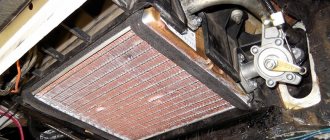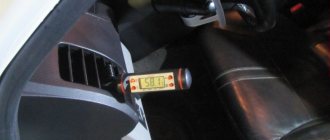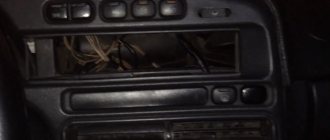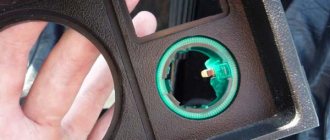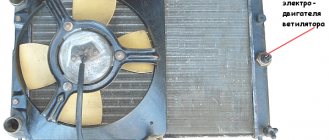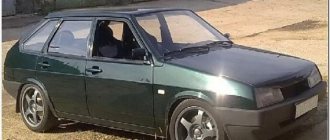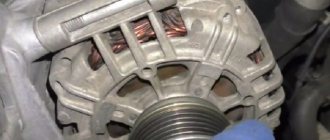Why does the stove not work on a VAZ 2114 car?
Unfortunately, the heating system of the domestic automobile industry still leaves much to be desired.
This issue is especially relevant in winter. After all, being cold is not only unpleasant, but harmful, even dangerous to health. And here we are not only talking about the driver’s hypothermia, everything is clear about this. Glasses with a faulty heating system quickly freeze and become covered with frost and ice. Visibility on the road for the driver in such conditions is negligible. To find out why the stove on a VAZ 2114 does not work, you first need to understand how the stove on a VAZ 2114 works.
Heating in the interior of the VAZ 2114 is arranged according to the classic principle of the line of Samara cars.
FAN WILL NOT TURN ON
Main reasons:
- brush wear. Since the stove fan is a conventional DC motor, its main problem is abrasion of the brushes used to supply voltage to the commutator. When the copper-graphite brushes wear out so much that the pressing force of the spring is no longer enough to make good contact, the fan operates at variable speed. For example, it may turn on after hitting the dashboard or driving through a pothole on the road;
- malfunctions in the electrical control circuit. Perhaps the reason is a soldered contact, since during operation certain parts of the electrical circuit can become very hot;
- oxidation of contacts, broken wires;
- fuse blown (we recommend reading how to properly replace the fuse). If after replacement the fuse blows again and again, you need to look for the section of the circuit where the short circuit occurs.
Repair of VAZ 2113—2115 stove fan
Why does the heater motor stop working? There are reasons for this, and there are several of them. However, most often the cause of malfunction is clogging. Dust gets everywhere, including inside the mechanism.
Cleaning the stove fan in some cases helps to improve the operation of the mechanism
Causes and signs of heater motor failure
With the onset of cold weather, correct and uninterrupted operation of the heater becomes more important. But according to the law of meanness, it is precisely at this time that frequent problems are observed that have their own reasons:
- The safety element fails, designed to monitor not only the heater along with its components, but also the glove compartment lighting, the optics washer motor, etc. This 30-amp fuse is located in a special block and is marked with the number F7. As a rule, the reason for its burnout is a short circuit. A burnt out element simply needs to be replaced.
Fuse F7 in the VAZ 2113 mounting block
The radiator of the VAZ 2115 stove deteriorates due to scale formation
If there is a malfunction, the additional heater resistor must be replaced
How to remove the fan
The VAZ 2113-2115 heater motor is removed as follows:
- First remove the side cover of the dashboard from the pedal side.
The side casing cover can be removed to facilitate the process of removing the fan.
The positive wire plug connects the fan to the car's electrical system.
The negative wire of the fan is connected to the mounting bolt on the body
After this, you need to transfer the work to the engine compartment:
- Unscrew the protective cover hiding the motor.
- Then remove the screws holding it in place.
The fan clamps are simply unscrewed with a screwdriver
The top fan cover can be removed in place to make motor removal easier.
Video: how to dismantle the heater motor on a VAZ 2115
How is the replacement carried out?
Before direct replacement, it is recommended to check the motor, because it may not work:
- Place the fan on a flat surface.
- Connect the wires to the battery terminals.
A faulty element will not rotate at all or will do so intermittently, weakly and noisily. Before work, you must also remember to thoroughly clean all debris from the niche where the new motor will be installed. The replacement procedure does not take more than 40 minutes for an experienced motorist. All you need is a screwdriver, wrenches and a new fan. The activity is performed in reverse to the withdrawal process. The wiring terminals must be securely secured so that they do not loosen while the machine is moving.
It is recommended to select a completely new and high-quality motor (original production) as a replacement in order to protect yourself from unnecessary costs. A good fan will last for a long time.
Where is the VAZ 2113-2115 heater relay located?
Not all motorists who decide to carry out repairs and replacements themselves can quickly find a faulty stove. The relay is responsible for sufficient heating of the interior, so a motor malfunction may be associated with it.
Often this element simply wears out. This is not a repairable part, it only requires replacement. Therefore, it is important to know where the relay is located in order to replace it yourself in a timely manner. The element is located on the center console under the instrument panel, often in the mounting block, next to the fuse.
The VAZ 2113-2115 heater relay is located near the fuses
The heater motor is an important and indispensable element of the car heating system. Periodic maintenance and timely replacement of faulty parts will always help keep the car interior warm.
Volkswagen Caddy › Logbook › Heater motor
Hello. Good day to all! Today there was a problem: the stove fan failed. Shows faint signs of life...barely audible in any gear. I checked with a tester the power is coming to the regulator. Apparently the fan has come to an end. Has anyone changed it? Do you want to do it yourself? the price is too steep... I would appreciate any help. Good luck to all
CONTINUATION I drove after what was written and listened. The motor actually makes some sounds as if it is stuck. While driving, I turned the heater on and off several times, everything remained unchanged. Sometimes the motor started spinning, but after 1-2 minutes it turned off. Arriving at the house, I removed the cabin filter and tried to turn the fan by hand. when turned off, it rotated freely without any extraneous sounds, but as soon as the stove was turned on, it barely noticeably began to rotate, then accelerating, then slowing down and stopping altogether... when I helped it with my hand and lifted it up a little, it clearly accelerated, but almost immediately stopped. About 2 months ago there was a similar picture, but it went away by itself, I just removed the air adjustment unit and put it back and that’s it. Now I think that the motor itself or the motor resistor could have burned out. HELP. Maybe someone has encountered this. I'll post if I figure it out.
Like 3 Subscribe
CAUSES OF HEATING SYSTEM MALFUNCTION
If the VAZ 2114 stove does not work, then the reasons for this must be sought among the following possible malfunctions:
- Fuse problems
A failed stove fuse is one of the most common, and at the same time easy to repair faults.
The fourteenth is equipped with a heater fuse of type F7, with a current strength of 30 A. It is worth noting that a failed heater fuse will also cause the cigarette lighter, glove compartment lighting, electric water supply pump to clean the headlights, and rear window heating to fail, since all these systems operate from one fuse.
Situations often occur when installed fuses blow out one after another - the reason for this may be a short circuit, to identify the source of which you will have to go through the entire safety circuit
- Lack of contact inside the mounting block
Also a fairly common problem, the cause of which is the oxidation of wires during operation. The solution is quite simple; you need to sort out the wiring in the block in which they are fastened in front of the mounting block, and, if necessary, replace the contact group.
- Problems with the ignition relay
A stuck ignition relay can also be the reason why the heater fan on a VAZ 2114 does not work. This is revealed quite simply - if the fan starts working only when the car’s engine has completely warmed up, then the problem is due to the ignition relay. To eliminate them, you will need to completely replace the relay.
- The stove does not work in speed modes 1 and 2
If the fan turns on only at maximum speed (there are 3 in total), then the heater resistor needs to be changed. The design features of the heating system are such that in speed modes 1 and 2 the fan is powered through an additional resistor, and in mode 3 - directly from the battery.
- Fan motor problems
If the VAZ 2114 cooling fan does not work, but all of the above problems have been eliminated, then one reason remains - a failed VAZ 2114 heater motor. It can either burn out or have poor contact with the power supply due to loose mass, and the fan brushes also often get stuck.
You will need to replace the heater motor with a new one, because if it starts to “stand out”, then this will happen repeatedly in the future.
Principle of operation
Due to the lack of a tap, the heating inside a domestic car is controlled by a hot air power damper. The adjustment is automatic, with an accuracy of two degrees Celsius. The damper has proven to be less practical than the faucet, as the latter can jam, stick or freeze. The main flow of heated or cooled air is evenly distributed throughout the cabin - first onto the windshield, and then passes through the deflectors closed with flaps to the side windows. The floor and footwells are heated using a similar principle. There is also an air recirculation system inside the cabin, which prevents an environmental disaster in the car due to unauthorized entry of outside air polluted and filled with road dust.
The stove fan of the tenth family operates in one of three modes: low, medium intensity and automatic selection. The mode depends on the number of additional 0.23 Ohm resistors in operation - one or two. Depending on the speed and air parameters, the digital control unit selects the optimal operating mode of a Soviet-style national air conditioner. The temperature is regulated using a controller. The driver can set the temperature in the range of 16-30 degrees with an interval of 2 degrees. Further, depending on the sensor readings, the fan begins to work with sufficient intensity to quickly warm up the air in the cabin, especially due to long periods of inactivity. In the first minutes after startup, the intensity of operation of the VAZ stove is quite high. Then it gradually decreases.
Replacement
Replacing a failed unit is not difficult. Follow certain rules and sequence of your actions to achieve the desired result.
- Disconnect the negative terminal from the battery.
- Lift the hood and in the engine compartment, remove all the mounting bolts that hold the plastic trim.
- For now, the overlay can be moved to the side so that it does not interfere with work.
- Remove the rubber seal, which also has its place in the engine compartment.
- Remove the protective cover from your heater motor. So you have reached the desired object and can begin replacing.
- On the sides of the motor are two bolts that hold your fan in place.
- Now go into the interior and remove the driver's side panel. There is a positive plug located there, which must be disconnected.
- Next, look for the negative wire. It is held on by one nut, which must be unscrewed.
- The disconnected wires are inserted into the hole in the body of your car, passing through the rubber seal.
- Remove the damaged motor. To do this, you need to turn it and pull it out through the right side.
Removing the motor-fan
As you can see, removing the device is not difficult. Having studied the condition of the fan motor, we can draw a conclusion regarding the need to replace it. Sometimes car owners get by with simply repairing brushes or replacing fuses.
Price issue
We advise you to choose a high-quality motor for replacement so that later there are no problems with its performance.
The motor itself will cost you about 500 rubles, and for the assembled device you will have to pay about 1000 rubles. Which option is preferable for you, decide for yourself.
Causes of heater fan malfunction
Replacing the stove motor may be necessary due to several problems, therefore, before taking active steps to repair the heating device, it is necessary to find out the reliable cause of the malfunction.
First of all, as practice shows, problems can begin with a failed fuse. Such a malfunction results in damage to the cigarette lighter, the illumination of the glove compartment, the electric pump (through which water cleans the headlights), and the heated rear window.
The second most common problem is the lack of contact, which should be inside the mounting block. In this case, the motorist needs to check the wiring in the block. If you have questions with the ignition relay, then most likely you will have to change this device. If the heater is not working in the first and second speed modes, the resistor will need to be replaced.
As practice shows, the heater fan on a VAZ-2115 can be replaced only after all of the above problems have been eliminated, and the faulty heater cannot operate normally. A problem with the fan motor can occur due to its failure. A small device may burn out, have poor contact with the power supply, or be the result of stuck fan brushes.
A simple algorithm for finding the causes of a malfunctioning stove in a car
The standard method for diagnosing stove malfunctions includes the following steps:
- Checking the coolant level in the expansion tank. If its level does not correspond to the marks, it is necessary to add antifreeze. Its volume is selected in accordance with the requirements of the car manufacturer.
- Checking for antifreeze leaks (wet spots under the car) should be carried out every morning before leaving the parking lot or garage.
- Visual analysis of smoke from the exhaust pipe. Its whitish color may indicate the presence of a breakdown.
- To check the serviceability of the stove fan, turn it on (with the engine running) and check it at different speeds. If you hear extraneous sounds, you should contact a car service for service.
- Air analysis in the car interior. If you smell a sweetish smell, it means that antifreeze is leaking from the stove into the interior.
- Checking the heater radiator temperature. If the engine does not heat up when the engine is running, then its cells are clogged.
- Computer diagnostics of the car climate control system.
Maintenance and repair of the stove is included in the list of works to prepare the vehicle for winter.
We recommend
Cleaning the radiator of a car heater
What to do if the stove blows cold air and the radiator needs to be flushed? There are several ways to do this.
1. Flushing the radiator with complete removal.
Dismantling a radiator is quite difficult; you cannot do it without knowledge of the car’s structure. However, in certain cases there is no other way to fix the problem. If you do not have positive experience with flushing the radiator, you should seek the help of professionals by contacting a service center.
Flushing with removal of the stove is required when other methods of cleaning the radiator have proven ineffective.
By removing the heater radiator, you can detect a number of faults. For example, you can see if the fan is functioning normally, and if there are problems, replace its motor.
In addition, only by dismantling the radiator can it be washed from the outside. If your car does not have a filter, be prepared for a large amount of dust and debris to accumulate on the air intake. The most dangerous is poplar fluff, which forms a thick caked crust. As a result, the heat exchanger stops blowing and generating heat.
You can assess the condition of the pipes, the degree of contamination of the radiator cells, as well as how tightly the air duct dampers fit when they are closed by removing the radiator. If in the closed position there are voids between the dampers and the stove, then air will come from outside, bypassing the radiator. Owners of not only budget but also expensive cars may encounter a similar problem. In the latter case, you should immediately contact a car service to solve the problem.
By dismantling the radiator, you can understand whether the cooling system as a whole is working. If the radiator is not functioning, cleaning will not help; you can solve the problem by replacing the entire cooling system. The cooling system becomes dirty gradually, but the moment the stove fails due to blockage is always unexpected. Repairing copper radiators involves sealing them, but if we are talking about aluminum, then replacing it will be a more expedient and cheaper solution to the problem.
Radiators are washed without using a pump, a sufficiently powerful pressure of hot water and a special bath. Washing is carried out using both homemade and professional cleaning products. Some methods are only suitable for a removed radiator, and using them at home is dangerous to health.
2. Washing with sulfuric acid.
To flush with sulfuric acid, the radiator must be removed, otherwise the rubber and plastic parts of the cooling system may be damaged. Today, this method is used very rarely and requires careful adherence to safety measures.
It is imperative to use special goggles, rubber gloves, a gown and a household respirator to protect against inhalation of toxic fumes. In addition, it is necessary to use special tongs or grips that prevent direct contact with the solution.
You also cannot do without a hydrometer, with which the concentration of the washing liquid is measured. Washing is carried out with a 15% solution of sulfuric acid. The hydrometer reading should be 1.1 g density per 1 cm3. The solution contains distilled water and battery electrolyte.
Remember that you should never pour water into acid; the acid must be carefully added to the water.
The method is suitable for flushing old copper radiators. Aluminum or zinc elements will fail after such treatment.
3. Cleaning with hydrochloric acid solution.
You should also not resort to this method if you lack experience. In addition, hydrochloric acid is not commercially available. As in the previous case, strict adherence to safety precautions is necessary.
If the contamination that has caused the stove to blow cold air is strong enough, then the cooling system should be filled with a 2% acid solution (50 ml per 1 liter of water). Then you will need to thoroughly and carefully flush the system with plain water. If the radiator is made of parts that are susceptible to corrosion, this cleaning method is not suitable.
4. Washing with caustic soda (caustic soda).
This method also causes heated debate. When using it, you must follow safety precautions; you cannot start washing without protective gloves; in addition, keep in mind that soda can corrode fabrics and is toxic.
Caustic soda is an alkaline detergent that cannot be found commercially. Using even a 5% solution will damage an aluminum radiator. The product is also harmful to zinc parts, zinc and aluminum alloys. It is recommended to be used if it is necessary to clean equipment before repair.
To prepare the solution, you need 50 g of caustic soda per 1 liter of distilled water. The radiator grille is placed in a bath filled with solution for several minutes, then removed and checked for dissolution of contaminants. If necessary, the procedure is repeated. At the end of the treatment, the radiator is washed with distilled water and dried.
Today, there are various ways to clean radiators from contaminants. Some of them raise reasonable doubts, since the necessary ingredients are not freely available, and the processing process is labor-intensive. It is better to resort to methods with minimal risk of damage to the vehicle and your own health, and also do not forget that you assume all the risks of such work.
DIAGNOSTIC TOOL
You can check whether power is coming to the heater motor connector using a regular test. But if we are talking about full diagnostics and searching for more complex faults, then you will need a multimeter. If you know how to use a multimeter, you can easily check the presence of power at the terminals of the connectors, determine the resistance, which will help you find a break in the wiring or identify a broken resistor. Also, checking the wires in resistance measurement mode can help find a short circuit.
To check PWM controllers on systems with electronically controlled heater fan speed, you will need an oscilloscope. Spending a significant amount on the purchase of this kind of diagnostic device for repairing a stove cannot be called a reasonable decision. If you use all the diagnostic methods described below and shown in the video, and the cause is still not found, we recommend contacting a professional electrician.
Possible causes of a malfunction of the heater fan on a VAZ-2114
Heater fan installed on a car
Before eliminating a malfunction that has occurred, it is necessary to establish the causes of its occurrence.
So, according to the experience of many motorists, the most common reasons are:
- Fuse blown.
- Failure of the contact group.
- Relay failure.
- Resistor.
- Switch.
- The fan motor burned out.
Now that the causes have been discussed, we can move directly to elimination methods.
Elimination methods
Many motorists think that a heater fan failure is associated only with a fuse or combustion of the motor that turns it, but this is far from the case. Let's consider all possible reasons in more detail.
Fuse blown
Mounting fuse block where the heater fan fuse is installed
The most common cause of all auto electrician troubles are fuses that fail.
So, in the case of a fan, the first thing you need to do is check the integrity of the fuse. If it is burnt out, it must be replaced with a new one. If this does not help, then you need to look for the reason elsewhere.
The heater fan fuse is marked with an arrow in the diagram.
You can find the fuse in the mounting block marked F7 .
Since the fan requires a lot of energy consumption, the rated current is 20A , so the fuse must be set no less than this figure.
Failure of the contact group
Another reason that is quite common in cars is oxidation of the contact group. To eliminate this malfunction, you need to clean the contact connections or simply move them.
Since the mounting block is located under the hood and water can get into it, it is necessary to protect it from moisture. You can do this in this simple way.
It often happened that the connections and connectors themselves had to be changed because they failed and were completely destroyed due to corrosion.
Relay failure
Relay block on a car
A relay failure will cause the stove fan to turn on briefly.
Sometimes, as practice shows, it may not turn on the first time, or only when the power unit is heated. The solution is quite simple - replacing the relay . You can find it under the dashboard of your car.
Resistor
The process of dismantling the heater resistor
A resistor malfunction occurs when the stove operates only in the extreme right position.
In this case, power will not be supplied, but only in the right position it is supplied directly, bypassing all other elements. Therefore, to eliminate the malfunction it is necessary to replace the part that has failed.
Switch
A fairly common malfunction is considered to be a failure of the switch or simply a breakdown of the contact connections.
Of course, it is not recommended to carry out repair operations, since incorrect restoration of an element, especially in the electrical part, can lead to the others breaking down. So, the manufacturer suggests that car enthusiasts with experience in DIY repairs recommend replacing the complete heater control unit.
Fan motor burnt out
Location of the heater fan under the hood
Motor combustion is the most unpleasant reason that can happen in this situation.
So, you will have to replace the stove fan completely, which will entail expensive parts. Some motorists, in this case, look for used motors at salvage yards, which are much cheaper.
On the left is a burnt out motor, on the right is a new one.
Of course, it is unknown how long such spare parts will last, so it is better not to skimp and buy a new one.
Volkswagen Caddy 2001, 64 l. With. - breakdown
Comments 1
Participate in the discussion can only registered users.
hi, just check the heater motor, remove it (it can be easily removed), after you remove it, just connect it to the battery, if the motor spins, then the problem is in the resistor. The heater on my caddie also stopped working one day, first I checked all the fuses, then I removed the heater motor, connected it to the battery, spun and spun, took it to an electrician, the diagnosis came up. I went to the market and bought another used motor, our price was 1000 rubles, I bought it. I installed it back on the car myself, I turn on the heater, it works, spruce spruce, I didn’t immediately understand what the hell was wrong, I went to an electrician, he checked everything, everything was fine, we didn’t know what the reason was, so we decided to check the cabin filter (located under the hood near the windshield on the passenger side, we removed the filter and it was all clogged with whatever you want (dirt, dust, leaves and all sorts of debris, well, we cleaned the filter and voila the heater started working, it was blowing abnormally. So check the motor first, if the motor is spinning it means the resistor, if the resistor is good then look at the cabin filter. GOOD LUCK
Full version of the site
Prevention
Preventing stove malfunctions comes down, first of all, to maintaining the cleanliness of the cooling system. Antifreeze should be changed every two years, choosing only high-quality liquid, and under no circumstances should it be mixed with the remnants of another type of coolant (for example, antifreeze). When replacing antifreeze, it is worth cleaning the cooling system by flushing with distilled water to remove all deposits, including those inside the stove. It is also important to keep the radiators and cabin filter clean.
Helpful advice: check the operation of the stove ahead of time - at the beginning of autumn, so as not to be left alone with the first frosts, trying to quickly find and fix the breakdown.
Replacement
- socket wrench 10;
- socket wrench 8;
- screwdriver with a Phillips bit.
- We park the car on a flat surface and immobilize it with the parking brake.
- Open the hood and disconnect the negative terminal.
- Using a 10mm wrench, unscrew the fastenings of the air filter housing.
- Using a screwdriver, loosen the air duct clamp on the air flow sensor and remove the corrugation.
- We unscrew the screws securing the cover of the air filter housing and remove the filter element.
- Using a size 8 wrench, unscrew the air intake mount and remove it.
- Using a 10mm wrench, then an 8mm wrench, unscrew the nuts securing the fan casing around the perimeter (6 pieces in total).
- Disconnect the wire block on the fan connector.
- Carefully remove the fan casing along with the drive.
- Using a 10mm wrench, unscrew the 3 bolts holding the electric motor to the casing.
- We put a new one in its place.
- We install the structure in place, fix it, and connect the connector.
- We carry out further installation in the reverse order.
votes
Article rating
